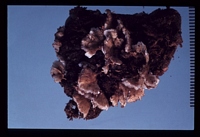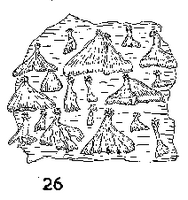|
 Postia dissecta Postia dissecta
SynonymsTyromyces exiguus
Polyporus exiguus
Polystictus drummondii
Polystictus exiguus
Polystictus sector
Polyporus dissectus
Polyporus catervatus
Polyporus stipitarius
Polystictus catervatus
Tyromyces catervatus
Rigidoporus catervatus
Polystictus dissectus
BiostatusPresent in region - Indigenous. Non endemic
Images (click to enlarge)
Caption: C-4129
Owner: Herb. PDD | 
Caption: Tyromyces exiguis x 3. Habit sketch showing flabelliform and spatulate pilei attached by narrow stem like bases to dead bark. Sketch shows a few of the many shapes found in any large collection.
Owner: Cunningham, G.H. |
Article: Cunningham, G.H. (1965). Polyporaceae of New Zealand. New Zealand Department of Scientific and Industrial Research, Bulletin 164: 304 p. Wellington:.
Description: Hymenophore annual, solitary or in crowded groups, coriaceous, attached by a small lateral base to 5 x 1 mm. Pilei simple or compound, flabelliform, 2-15 mm wide, 5-15 mm radius, 0.5-1 mm thick; pileus surface white, drying ochre, fawn, chestnut, or umber, concolorous, markedly radiate-striate, even, polished or finely velutinate in depressions; without a cortex; margin acute, revolute, crenate and toothed; hymenial surface grey or cinnamon, even, sterile border to 1 mm wide. Pores alutaceous in section, irregular in size and shape, angular, seldom round, 4-6 per mm, 50-150 µm diameter, to 1 mm deep; dissepiments 75-150 µm thick, most about 100 µm, equal, apices finely velutinate. Context alutaceous or isabelline, 0.2-0.6 mm thick, of radiately arranged parallel hyphae; generative hyphae 5-6 µm, diameter, walls 2 µm, thick, sparsely branched, septate, with clamp connections. Hymenial layer to 16 µm deep, a dense palisade of basidia and paraphyses. Basidia subclavate, 12-15 x 3-4 µm bearing 2-4 spores; sterigmata erect, to 3 µm long. Paraphyses subclavate, 8-12 x 2-2 .5 µm. Spores oblong, elliptical, or pip-shaped, 3-4.5 . 2-2.5 µm, walls smooth, hyaline, 0.1 µm.
Habitat: Decorticated decayed logs mainly of conifers lying upon the forest floor, often among mosses and on burnt wood.
Distribution: New Zealand, Australia.
Notes: Recognised by the small flabelliform pilei attached by small lateral stem-like bases, white surface when fresh drying from dingy white through tan or chestnut to umber, moderately sized irregular pores, small elliptical spores, and generative hyphae radiately arranged. Plants commonly grow upon sides or surfaces of fallen decayed logs, upright stems and not infrequently on charred wood, often among mosses. They may range in length from 2 to 15 mm. In a few specimens they are pezizaeform and attached by a narrow vertex, then resembling Tyromyces catervatus. From the latter these forms may be separated by the entire dissepiments and elliptical spores. The type collection was sent to Kew herbarium by Colenso and by Cooke named Polyporus exiguis, and this name was published by Colenso as - "P. exiguis sp. nov. A small semistipitate flabellate whitish fungus, of horizontal growth, among mosses, on the bark of old trees near their bases: wet woods ... near Norsewood, 1883, W.C." Two years later it was more formally described by Cooke under the name Polystictus exiguis Cke. If Colenso's description is regarded as valid, for the period, then the species may be cited as Tyromyces exiguis (Col.); if not, then it should be T. exiguis (Cke.) and the place of publication of the combination, this volume.
Article: Cunningham, G.H. (1948). New Zealand Polyporaceae. 3. The genus Polyporus. New Zealand Department of Scientific and Industrial Research, Plant Diseases Division, Bulletin 74: 39 p.
Description: Hymenophore annual, solitary or in crowded groups, laterally attached by a small stem-like
base. Pileus simple or compound, 2-15 mm. x 5-15 mm. x 0.5-1 mm., white, ochre, fawn or
umber; surface concolorous, markedly radiate-striate, even, polished or delicately tomentose
in depressions, cuticle wanting, replaced by imbricate parallel hyphe of which a few possess
pigmented contents; margin acuminate, revolute, crenate and toothed; hymenial surface grey
or cinnamon, even, sterile margin 1 mm. wide, dissepiments not toothed. Context 0.2-0.6
mm. thick, clay colour or isabelline, of radiately arranged parallel hyphae ; generative hyphae
5-6 µ thick, wall 2 µ, sparsely branched, septate, with abundant conspicuous clamp
connections. Pores decurrent, irregular in shape and size, angular, seldom round, to 1 mm.
deep, clay colour in section, 50-150 µ diameter, or 4-6 per mm.; dissepiments 75-150 µ thick,
mostly 100 µ, equal, of woven hyphae, apex finely velutinate. Basidial type clavate, basidia
clavate, 12-14 x 3-4 µ. Spores oblong, elliptical, or pip-shaped, 3-4.5 x 2-2.5 µ, smooth,
hyaline.
Habitat: Growing on decorticated rotting logs lying on the forest floor, often amongst
moss.
Distribution: New Zealand.
Notes:
Specimens forwarded to Kew by W.Colenso were named by M.C.Cooke. The name was
published by Colenso as Polyporus exiguis sp. nov., but no description was appended.
Subsequently Cooke formally described it as Polystictus exiguis Cke.
Specific characters are the small size, laterally attached flabelliform pilei, white (when fresh)
surface, irregular moderately sized pores, and small elliptical spores. Pilei of a few specimens
resemble those of P. catervatus in that they are peziza-like, caespitose and attached by a
prolongation of the vertex. Such may be separated by the larger more deeply coloured pores,
entire dissepiments and elliptical spores.
Though superficially not apparent, the species belongs to the same section as P.
anthracophilus, possessing a monomitic hyphal system, and similar radiately arranged
parallel hyphae.
Article: Cooke, M.C. (1886). Praecursores ad Monographia Polypororum. Grevillea 15(73): 19-27.
Notes: Pileus 3-5 mm., scarcely more; stem sometimes 2-3 mm., sometimes none ; pores 1/6
mm.
Article: Cooke, M.C. (1879). New Zealand fungi. Grevillea 8(46): 54-68.
Article: Cunningham, G.H. (1948). New Zealand Polyporaceae. 3. The genus Polyporus. New Zealand Department of Scientific and Industrial Research, Plant Diseases Division, Bulletin 74: 39 p.
Description: Hymenophore annual, coriaceous, pendulous, obconic or discoid, attached by a short
expansion of the vertex, to 4 mm x 1-3 mm. Pileus when solitary orbicular, discoid, 5-15 mm.
diameter, 1-1.5 mm. thick, usually merging at the margins then forming caespitose groups
which are patellate, to 5 cm. x 2 cm. and attached by numerous stem-like projections; surface
smooth, polished, often radiately striate, grey, bay-brown or umber, cuticle wanting, replaced
by imbricate partly cemented hyphae; margin usually revolute, entire or finely toothed, acute,
when pilei are caespitose only peripheral margins are apparent; hymenial surface cream or
ochraceous, concave, dissepiments strongly toothed, often tearing into segments. Context
0.2-0.5 mm. thick, grey or bay-brown, of parallel radiately arranged hyphae firmly
compacted; generative hyphae 4-8 µ thick, wall 1.5-2 µ, sparsely septate, branched, clamp
connections scanty, staining. Pores round or irregular, to 1 mm. deep, straw- or wood-colour
in section, 50-100 µ diameter, mostly 75 µ, or 9-10 per mm.; dissepiments 25-50 µ thick,
equal, of parallel densely compacted hyphae, apices even, brittle. Basidial type clavate,
basidia clavate, to 12 x 4 µ, persistent. Spores globose, 4-4.5 µ diameter, smooth, hyaline,
abundant.
Habitat: Growing usually caespitose on bark or decorticated wood on the under surface of
fallen branches and logs.
Distribution: New Zealand.
Notes: Pilei grow pendulous upon the under side of fallen logs, attached by a brief extension of the
vertex. When solitary they assume a discoid shape with the hymenium downward; when
caespitose, the common condition, the pilei merge to form large dish-shaped bodies attached
by numerous short apical extensions. Occasionally plants assume a flabelliform shape, and
are then attached by. a lateral extension of the pileus. Such forms resemble pilei of P. exiguis
from which they may be separated by the minute pores, prominently toothed dissepiments,
lighter colour of the hymenophore, and globose spores. Dissepiments are very thin and
delicate. In old specimens the hymenium may become much creviced and torn, when it is
difficult to detect the pores.
In Fries' herbarium at Upsala I saw specimens named P. catervatus by M.C.Cooke. They had
been collected in July 1874, at Wellington by S.Berggren and are identical with specimens
described above and the illustration given by Berkeley (l.c., Pl. CV., Fig. 1.)
|